Great white sharks are the largest predatory fish in the world. They are as fascinating and gigantic as they are scary and mythological.
But how big can these apex saltwater predators really get?
While their actual maximum size remains a mystery, the largest great white sharks known today have a maximum size of about 20 feet and 5,000 pounds. Their average size is between 10 and 16 feet and 1,000 and 2,500 pounds.
Keep reading this article to learn more interesting facts about the maximum size of male and female great whites, how old this shark species can get, and how much the biggest great white shark on record measured.
What Is the Maximum Size of Great White Sharks?
The great white shark (Carcharodon carcharias) is one of our oceans’ biggest sharks and largest predatory fish.
Female great whites grow larger than males and can reach a maximum length of an incredible 20 feet and a maximum weight of between 4,000 and 5,000 pounds.
On the other hand, male great white sharks can typically reach a maximum length of about 17 feet and a maximum weight of around 3,000 to 4,000 pounds.
Such sizes are extremely impressive, but they’re also very rare, as the vast majority of both male and female great whites will have smaller average sizes!
What Is the Average Size of Great White Sharks?
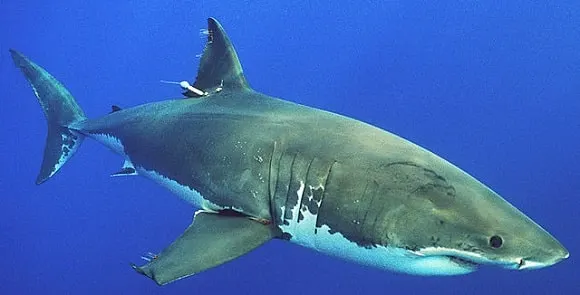
The average great white is still a very large animal that measures over 10 feet and weighs a thousand or more pounds.
Once again, female great white sharks are bigger than their male counterparts.
Adult female white sharks have an average length of 14 to 17 feet and an approximate average weight of 1,500 to 2,500 pounds.
The average adult male great white has a length of about 10 to 13 feet and a weight of 1,000 to 1,700 pounds.
In other words, a 2000-pound 15-footer is a fairly normal-sized fish. That’s both fascinating and scary!
Of course, average sizes will vary depending on the sharks’ habitat and forage.
Great whites found in the colder waters of the northern Atlantic or Pacific, say off the coast of New England or Alaska, may have a smaller average size than white sharks found in the warm and fish-rich waters around South Africa.
Their average size may also vary from year to year, as great white sharks tend to migrate frequently and cover distances of up to 1,000 miles.
Obviously, a specimen will have lost some weight after such a journey.
On the contrary, a white shark that spends plenty of time off the coast of South Africa might be extremely well-fed and hence have a much larger average size than other sharks.
What Is the Biggest Great White Shark Ever Caught?
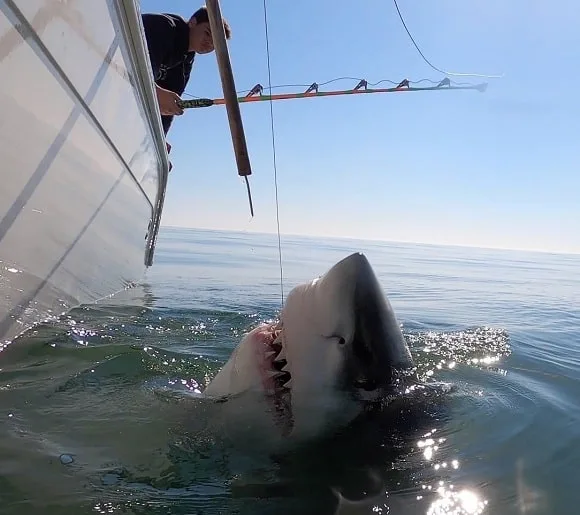
The official IGFA All-Tackle great white shark world record is a fish caught off the coast of Ceduna (Australia) in 1959.
Shark angler Alfred Dean hooked up to and eventually managed to land a giant great white of an insane 2,664lb.
Rumors have it that it only took about 70 minutes to get this beat to the boat, but, being an angler myself, I remain a skeptic.
A fish of such an enormous size has immense powers, and white sharks don’t give up easily!
To think that a human being could reel in such a monster in a little bove ran hour seems highly unlikely. But who knows, right? Let’s give Mr. Dean the benefit of the doubt.
Because regardless of the time it took to land that fish, it’s a catch of a lifetime! No doubt about that.
However, unofficially, that shark is not the biggest one ever caught on rod and reel!
In 1986, the New York Times published an interesting article about an angler who’d allegedly caught a great white of over 3,000 pounds.
The behemoth weighed in at an unbelievable 3,450lb, to be exact. It was caught off Montauk (New York) by angler Donnie Braddick.
There were plenty of spectators, boats, and anglers around that day, and apparently, there were several reliable witnesses at the weigh-in.
So, the shark’s weight holds up!
According to the International Game Fish Association, what didn’t, hold up was Mr. Braddick’s line strength.
Being at a 150lb test, it exceeded the association’s maximum line strength category, which at the time was a 130lb test.
And so, they couldn’t or didn’t want to make the catch an official all-tackle world record.
Too bad if you ask me! Because a great white of such a caliber would have made a mighty worthy record!
What Is the Biggest Great White Shark on Record?
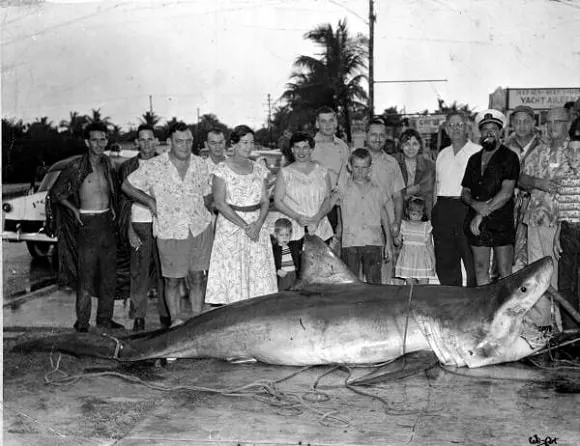
If you thought those rod and reel-caught fish were big, get ready for the biggest great white shark ever recorded! They are monstrous!
First, there are many stories of reported giant great whites on the internet, but not all of them are true.
For example, I have read about a 35 and a 36-footer, which were later debunked by experts and researchers for being way out of proportion.
Similarly, a few stories stated that the biggest ever recorded great whites were at most 16 or 17 feet.
Both stories are false, and, unfortunately, it’s always difficult to be 100% certain when it comes to record-sized fish.
Nevertheless, a few reports are highly reliable and have been backed by both experts and authorities. Let’s stick to those, shall we?
The biggest living great white shark on record is a female called Deep Blue. And boy, is she an impressive girl!
Her length and weight have only been estimated as Deep Blue has never been caught and is still roaming the oceans. But the numbers appear to be very accurate.
This female great white measures 20 ft and weighs an incredible 4,409lbs. Yes, that’s more than 2 tonnes!
Furthermore, she has a height (read depth) of 8 feet. That means that Deep Blue is deeper than the tallest man on earth.
It’s an extraordinarily round and fat fish. And wherever she shows up, people are amazed when they spot her.
The biggest great white shark of all time is a Cuban legend. However, the myth became real when a Discovery Channel documentary confirmed its massive size.
“El Monstruo de Cojimar“, as the Cubans call this fish to this day, was caught in 1945, reportedly measured 21 ft and had a weight of 7,328lbs.
If true, this ocean giant weighed almost twice as much as Deep Blue.
Now, we’ll probably never know if the length and weight are 100% accurate, but there were many eyewitnesses and even a picture taken of the beast.
This, combined with countless reports and expert reviews, makes El Monstruo a fairly realistic catch.
And so, if great whites can weigh more than 7,000 pounds, who knows how big they can really get?
Is There a 30-Foot Great White Shark?
These giant fish then beg the question: are there even bigger sharks of 30 feet or more out there somewhere?
We don’t know, but if you ask me, it’s probably very likely!
For one thing, our oceans are vast, and we’ve only discovered and charted 5% of them. That’s right; 95% of our seas are still uncharted territories! Imagine what giants could be swimming around in that 95%!
For another thing, reports of 30-foot sharks (and beyond) have been made over the centuries. And while almost all of them are unofficial, unconfirmed, or regarded as myths, who knows if some aren’t true?
If those fish have never been caught, seen, or recorded, we can’t for sure know if they exist or not.
Under the right circumstances, meaning genetics, age, habitat, water temperature, and food abundance, I guess great whites of 25 or even 30 feet could be possible!
We won’t know until we know. And that’s part of the mystery and charm!
Where Are the Biggest Great White Sharks Found?
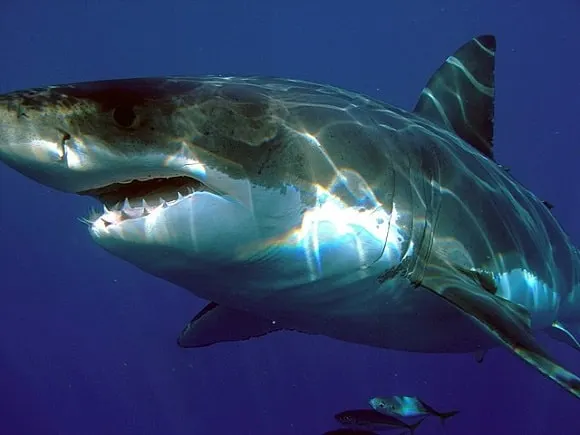
According to most sightings, research papers, and reports made by commercial and recreational fishermen, the biggest white sharks appear to be concentrated around South Africa, the Gulf of Mexico, the Caribbean Sea, and off Western Australia.
However, as these fish are highly migratory, huge specimens can show up anywhere, as great whites inhabit many coastal and offshore waters around the world.
Still, South Africa, the Gulf of Mexico, the Caribbean Sea, and Western Australia stick out in several regards:
- There are plenty of breeding grounds found in these areas
- Water temperatures are perfect for great whites
- There’s plenty of food around
These three main factors result in a high concentration of great whites in these areas.
When it comes to South Africa, though, the picture has changed in recent years.
Once known as the white shark capital of the world, many great whites now appear to avoid the waters off South Africa.
However, the reason isn’t human activity. But orcas!
Packs of killer whales are apparently hunting down great whites in this region, resulting in sharks avoiding these waters.
It’s a fascinating theater of nature that researchers are only starting to discover and understand.
DID YOU KNOW: The waters around Dyer Island off South Africa are still still as one of the world’s hot spots for great whites!
How Fast Do Great White Sharks Grow?
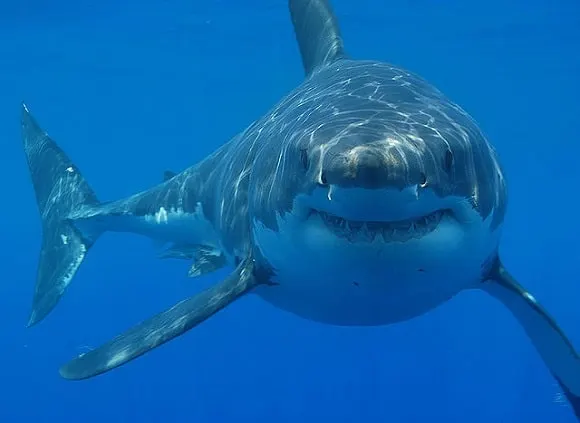
Due to the higher temperatures and food abundance of the waters they inhabit, great white sharks are relatively fast-growing fish.
At birth, they typically already measure more than three feet. And each year, they add about 10 to 12 inches to their length.
Consequently, a 2-year-old “toddler” great white in top condition can already measure 4 to 5 feet, and a 3-year-old juvenile can measure up to 6 or even 7 feet!
This also results in relatively early sexual maturity for both male and female fish.
Male great whites reach sexual maturity at around ten years and a length of about 12 feet.
On the other hand, females reach sexual maturity at around 14 to 16 years and a length of 15 feet.
However, once they do reach the age of sexual maturity, their growth rate starts to slow down considerably.
How Long Does It Take a Great White Shark to Reach Full Size?
The answer to this question depends on how you want to define “full size”. If a great white is fully grown once it reaches sexual maturity, the answer is about 10 to 12 years for males and 14 to 16 years for females.
If “full size” refers to their maximum size, it can take 25 to 50 years for them to reach it.
RELATED ARTICLE: How big do Florida pompano get?
Do Great White Sharks Keep Growing?
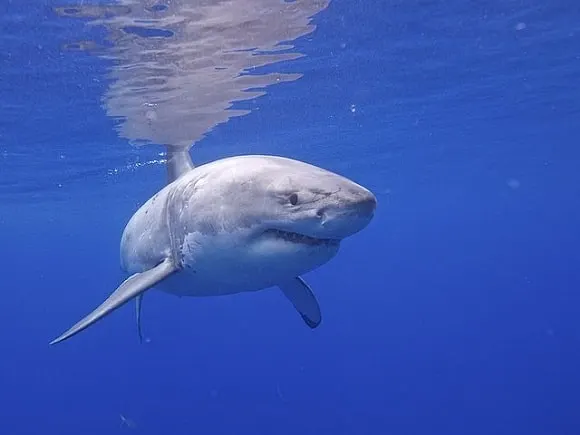
Great white sharks keep growing until the end of their life.
Though thankfully, they do not maintain a 10-inch per year growth rate.
Otherwise, no one would dare to go swimming in the ocean because that would mean that a 30-year-old great white would have an approximate length of 25 feet. Even older fish would then be regular sea monsters.
Instead, their growth rate slows down once they reach sexual maturity at around age 10 (for males) and 15 (for females).
After that, they will grow approximately 1 to 3 inches per year.
How Old Do Great White Sharks Get?
While it was long believed that great whites had a maximum lifespan of 30 to 40 years, recent studies have shown that they can get as old as 70 to 80 years, possibly even older than that.
In 2014, a research team studying white sharks in the northwestern Atlantic Ocean found a specimen with an estimated age of 73 years.
They estimated the shark’s age by counting the growth rings on the fish’s vertebra, which is the scientifically approved method of estimating the age of a great white shark.
Once again, this shows how little we actually know about this species and our ocean in general.
It also supports the hypothesis that they might be much older and bigger great white ones out there!
And so, while the oldest great white shark officially on record is the famous specimen Deep Blue, this ancient shark, studied by the research team in the northwestern Atlantic Ocean back in 2014, should get this title.
Unfortunately, the research report doesn’t state the weight of that extremely old great white.
Are Great White Sharks Getting Bigger?
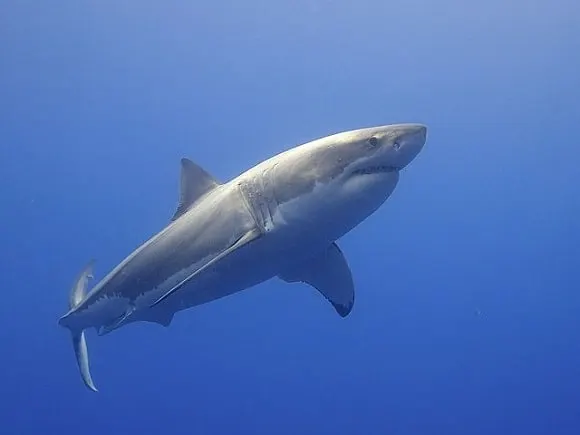
These new findings beg the question: Are today’s great white sharks getting older and, consequently, bigger? Or do we simply find new and more advanced methods of determining their age?
Both, as it turns out!
Thanks to decades of legislative work and marine protection programs, many shark populations have benefitted from the increased protection and food abundance in these areas.
This has led to larger populations and longer and fatter fish.
Scientists have observed several 15 and 16-foot tiger sharks and far more 18 to 20-foot great white sharks than ever in regions such as the waters around Hawaii or French Polynesia, where shark protection efforts have been incredibly successful in recent years.
Additionally, many countries have tightened their pollution laws, resulting in cleaner water in many coastal areas, further benefitting shark populations.
The funny thing is that their growing numbers and sizes are now (by some) regarded as a threat.
True, there have been a few more shark attacks and fatalities than usual in 2021 and 2022. But we shall not forget that these animals belong to the sea and that great white sharks have been critically endangered for many decades.
In 2022, there were a total 6 fatalities due to shark attacks worldwide. Six!
The most recent number of war-related fatalities and wounded in the ongoing war between Russia and Ukraine is now around 200,000.
That should give us all some perspective when comparing nature and humanity!
RELATED ARTICLE: What Is the Maximum Size of Great Hammerhead Sharks?
Were Prehistoric Great White Sharks Bigger?
As it turns out, prehistoric great whites and their close relatives used to get much bigger than today’s great white sharks.
Based on a 4- to 5-million-year-old fossil of a great white found in Peru, researchers could estimate that ancient white sharks could reach maximum lengths of around 30 feet.
Interestingly, those prehistoric great whites were not related to the famous megalodon, the largest shark that has ever roamed our planet’s oceans.
Instead, they were most likely related to and have evolved from the ancient versions of today’s mako sharks.
And even though the great whites of today are typically somewhat smaller than those prehistoric giants, they probably still carry that DNA and, with it, the possibility to, one day, regain their former glory and size!
Time will tell, I guess.
Related Articles
- How Big Do Tiger Sharks Get?
- What Is the Biggest Halibut Ever Caught?
- What Is the Maximum Size of Giant Goliath Groupers?
Featured image courtesy of Terry Goss, CC BY 2.5

